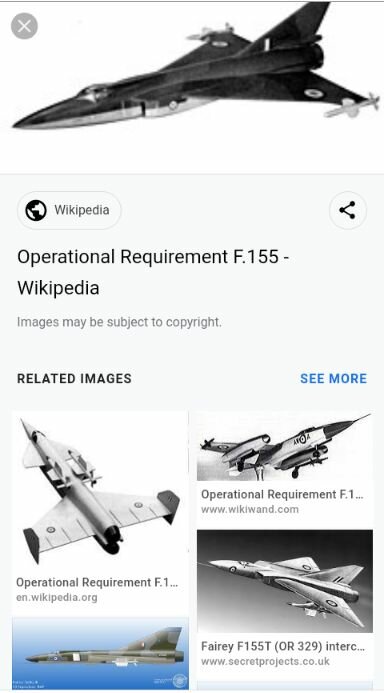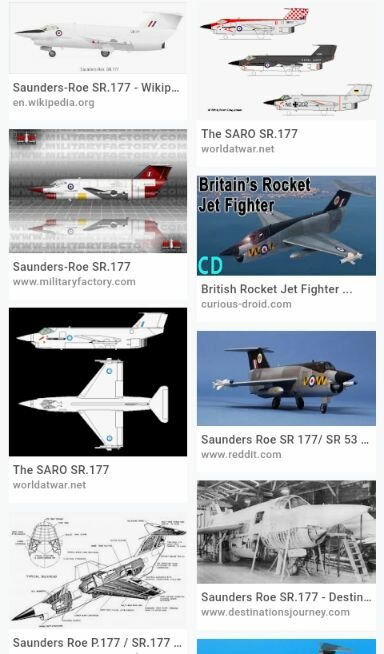starviking
Like I said it's all details, details, details.
If one is prepared to completely revise the front section, then adequate room for the 35" set intended for OR.346 is achievable. Literally that is the basis of early Vickers studies towards OR.346.
The more constrained changes see just the dish ahead of the cockpit, so quite a bit of heavy duty cable to pipe the send and recieve signal from and to the radar signal processing elements packaged behind the radar operators seat.
The SLAR set option ate into both fuel and avionics bays. Not ideal. I think it wasn't worth trying to fit this to any fighter....unless we're talking something Red Barrel scale.
Though I feel the whole SLAR AEW system was actually worth more investigation. As this had much more potential than FMICW for the role. Mates more neatly with Marconi's work on STAR later on as I suspect it might with ASWRE's.
Similarly with the wing, which as I said has the modest benefit of being like the Harrier wing, an assembly bolted to the top of the fusilage. So relatively 'easy' to examine alternatives (a wise move by the designers of the time). But devils lurk there!
The missile particulars obviously impact storage both inside a given weapons bay and outside on pylons. What I've seen on TSR.2 diagrams is essentially Red Top, and I think some Falcon derivative (Genie?). Which are bulky and without folding fins.
The OR.346 studies with a very similar weapons bay certainly manage two or four of the John Forbat AAM (which I tend to call Red Card) and similar for certain size/weight of HSA Family missiles.
--------
Now a general point.
By cancelling F.155 and F.177, no matter the logic, it also cut the spreading of development efforts for new supersonic aircraft and avionics.
As it did Hunter and Javelin successors. Which ultimately still needed replacement.
Leaving only the new OR.339.
And everything had to be carried by this program.
This got worse because that effort still needed to happen and soon had to spread to cover NMBR.3 and OR.346. Only now the case for replacement was becoming more pressing.
By '63 Soviet display of new Anti-ship Missiles and aircraft drove a revaluation of defensive requirements. Increasing the urgency of FAA replacement of Sea Vixen and backup upgrade. This was causing a modest storm inside the USN as E2 started to hit problems.
This is why AMTI system is flown on a substantially improved performance AI.18 and priced up by GEC as a fall back option.
And it's why options like Type 583/584/585 are not chosen despite being a perfect match to AW.406.
It why cludged VG Lightning options are thrown at the problem.
And why Shorts hit up on not it's own NMBR.3 offering but a modified licensed F8 two seater.
Also why the RN could successfully argue it cannot wait for P.1154RN, even with improved AI.23 and Red Top MkII.
F4 NOW buys us time to keep ahead of the increasing threat and their eyes are increasingly looking at the USN F111 system.
The basis of the Class II Fighter.
Which our theory and avionics figures will say they can achieve if funded. Confirming the US will likely achieve it.
Like I said it's all details, details, details.
If one is prepared to completely revise the front section, then adequate room for the 35" set intended for OR.346 is achievable. Literally that is the basis of early Vickers studies towards OR.346.
The more constrained changes see just the dish ahead of the cockpit, so quite a bit of heavy duty cable to pipe the send and recieve signal from and to the radar signal processing elements packaged behind the radar operators seat.
The SLAR set option ate into both fuel and avionics bays. Not ideal. I think it wasn't worth trying to fit this to any fighter....unless we're talking something Red Barrel scale.
Though I feel the whole SLAR AEW system was actually worth more investigation. As this had much more potential than FMICW for the role. Mates more neatly with Marconi's work on STAR later on as I suspect it might with ASWRE's.
Similarly with the wing, which as I said has the modest benefit of being like the Harrier wing, an assembly bolted to the top of the fusilage. So relatively 'easy' to examine alternatives (a wise move by the designers of the time). But devils lurk there!
The missile particulars obviously impact storage both inside a given weapons bay and outside on pylons. What I've seen on TSR.2 diagrams is essentially Red Top, and I think some Falcon derivative (Genie?). Which are bulky and without folding fins.
The OR.346 studies with a very similar weapons bay certainly manage two or four of the John Forbat AAM (which I tend to call Red Card) and similar for certain size/weight of HSA Family missiles.
--------
Now a general point.
By cancelling F.155 and F.177, no matter the logic, it also cut the spreading of development efforts for new supersonic aircraft and avionics.
As it did Hunter and Javelin successors. Which ultimately still needed replacement.
Leaving only the new OR.339.
And everything had to be carried by this program.
This got worse because that effort still needed to happen and soon had to spread to cover NMBR.3 and OR.346. Only now the case for replacement was becoming more pressing.
By '63 Soviet display of new Anti-ship Missiles and aircraft drove a revaluation of defensive requirements. Increasing the urgency of FAA replacement of Sea Vixen and backup upgrade. This was causing a modest storm inside the USN as E2 started to hit problems.
This is why AMTI system is flown on a substantially improved performance AI.18 and priced up by GEC as a fall back option.
And it's why options like Type 583/584/585 are not chosen despite being a perfect match to AW.406.
It why cludged VG Lightning options are thrown at the problem.
And why Shorts hit up on not it's own NMBR.3 offering but a modified licensed F8 two seater.
Also why the RN could successfully argue it cannot wait for P.1154RN, even with improved AI.23 and Red Top MkII.
F4 NOW buys us time to keep ahead of the increasing threat and their eyes are increasingly looking at the USN F111 system.
The basis of the Class II Fighter.
Which our theory and avionics figures will say they can achieve if funded. Confirming the US will likely achieve it.


